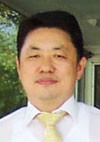ITER NEWSLINE
8
In support of ITER
by Young-Hwan Kim, DDG Designate, Central Engineering and Plant Support Department (CEPS)

Young-Hwan Kim
In addition to the Design Office, the CEPS Department has responsibility for the pellet injector, the steady state electrical power network, the coil power supplies, the hot cell and radwaste services integration, the radwaste treatment and storage, the radiation monitoring, the vacuum systems, the tritium plant, the cooling water systems, and the cryogenics systems and distribution. So in many ways, the CEPS Department represents the life blood of the ITER project.
This year, the ITER Design Review is the highest priority. The list of actions resulting from the Review are used to generate a series of work plans, which detail what actions and resources are needed to finish the specifications of the Procurement Packages in time. Staffing and resource requests are then based on these estimates.
The input from the group working on the tritium plant issues (one of the eight Design Review working groups) has been given a more permanent character by the formation of a new Tritium Plant Project Team, including one member of each Participant Team, which will help steer the activities of the Tritium Plant Section and commit resources needed to generate detailed design packages in the tritium plant area. A similar team was formed by the Cryogenics Section.
The other sections in our Department are filling up quickly and starting their operation, on which we will report in a separate article on a later date.
return to Newsline #8


